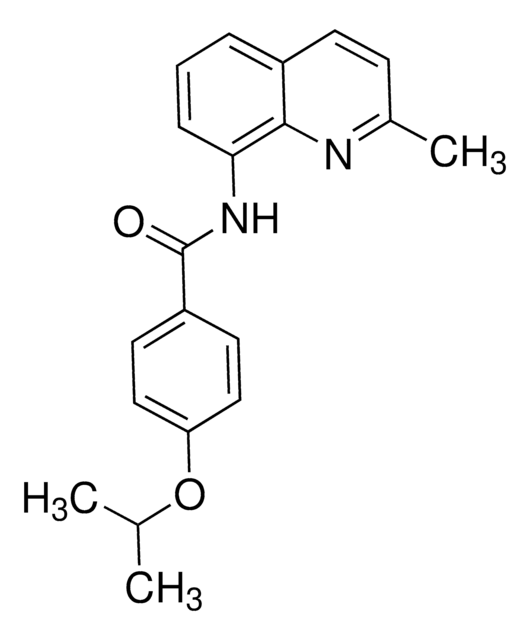推荐产品
化驗
≥97% (HPLC)
形狀
powder
顏色
white to beige
溶解度
DMSO: 2 mg/mL, clear
儲存溫度
−20°C
SMILES 字串
C1(NC2=CC(C3CC3)=NN2)=CC=NC(NC4=CC=C(N=CN5)C5=C4)=N1
InChI
1S/C17H16N8/c1-2-10(1)13-8-16(25-24-13)22-15-5-6-18-17(23-15)21-11-3-4-12-14(7-11)20-9-19-12/h3-10H,1-2H2,(H,19,20)(H3,18,21,22,23,24,25)
InChI 密鑰
WJNBSTLIALIIEW-UHFFFAOYSA-N
一般說明
APY29 is considered as a type I kinase inhibitor of inositol requiring kinase enzyme 1 α (IRE1α).
生化/生理作用
APY29 has the ability to enhance inositol requiring kinase enzyme 1 α (IRE1α) (P830L)′s oligomeric state to rescue RNase activity.
APY29 is a small molecule that inhibits the kinase activity of IRE1α (in vitro autophosphorylation IC50 = 280 nM) by targeting its active site ATP-binding pocket, while simultaneously acting as an allosteric activator of IRE1α RNase activity (EC50 = 460 nM) by keeping the active site in an open conformation. When applied 1 hr prior to stress induction by 4-hr 6 nM thapsigargin treatment, APY29 significantly potentiates stress-induced unfolded protein response (UPR) in rat insulinoma INS-1 cultures (XBP1 mRNA processing induction = 54% without vs. 78% with 1-hr 3 μM APY29 pretreatment).
儲存類別代碼
11 - Combustible Solids
水污染物質分類(WGK)
WGK 3
閃點(°F)
Not applicable
閃點(°C)
Not applicable
Rajarshi Ghosh et al.
Cell, 158(3), 534-548 (2014-07-16)
Depending on endoplasmic reticulum (ER) stress levels, the ER transmembrane multidomain protein IRE1α promotes either adaptation or apoptosis. Unfolded ER proteins cause IRE1α lumenal domain homo-oligomerization, inducing trans autophosphorylation that further drives homo-oligomerization of its cytosolic kinase/endoribonuclease (RNase) domains to
Alexei V Korennykh et al.
BMC biology, 9, 47-47 (2011-07-07)
The unfolded protein response (UPR) controls the protein folding capacity of the endoplasmic reticulum (ER). Central to this signaling pathway is the ER-resident bifunctional transmembrane kinase/endoribonuclease Ire1. The endoribonuclease (RNase) domain of Ire1 initiates a non-conventional mRNA splicing reaction, leading
Airong Su et al.
Viruses, 9(9) (2017-08-24)
In response to the endoplasmic reticulum (ER) stress induced by herpes simplex virus type 1 (HSV-1) infection, host cells activate the unfolded protein response (UPR) to reduce the protein-folding burden in the ER. The regulation of UPR upon HSV-1 infection
Alexei V Korennykh et al.
BMC biology, 9, 48-48 (2011-07-07)
Ire1 is a signal transduction protein in the endoplasmic reticulum (ER) membrane that serves to adjust the protein-folding capacity of the ER according to the needs of the cell. Ire1 signals, in a transcriptional program, the unfolded protein response (UPR)
Megan M Robblee et al.
Cell reports, 14(11), 2611-2623 (2016-03-15)
Diets rich in saturated fatty acids (SFAs) produce a form of tissue inflammation driven by "metabolically activated" macrophages. We show that SFAs, when in excess, induce a unique transcriptional signature in both mouse and human macrophages that is enriched by
我们的科学家团队拥有各种研究领域经验,包括生命科学、材料科学、化学合成、色谱、分析及许多其他领域.
联系技术服务部门








